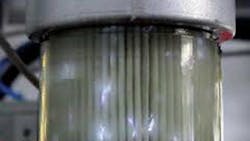How And Why To Monitor Hydraulic Filter Condition
Continuous monitoring of the filter elements in a hydraulic system can provide valuable clues to the performance of the filter and the condition of the system. But before discussing this, let's consider some of the advantages and disadvantages of common filter locations in a hydraulic system.
Pressure filtration
Locating filtering media in the pressure line provides maximum protection for components located immediately downstream. Filtration rates of two microns or less are possible, due to the positive pressure available to force fluid through the media. Filter efficiency may be reduced by the presence of high flow velocities, and pressure and flow transients, which can disturb trapped particles. The major disadvantage of pressure filtration is economic. Because the housings and elements (high-collapse type) must be designed to withstand system operating pressure, pressure filtration has the highest initial and ongoing cost.
Return filtration
The rationale for locating filtering media in the return line is this: if the hydraulic reservoir and the oil it contains start out clean and all air entering the reservoir and returning oil is adequately filtered, then fluid cleanliness will be maintained. The other advantage of the return line as a filter location is that sufficient pressure is available to force fluid through fine media - typically 10 microns, but pressure is not high enough to complicate filter or housing design. This combined with relatively low flow velocity, means that a high degree of filtering efficiency can be achieved at an economical cost. For these reasons, return line filtration is a feature of most hydraulic systems.
Off-line filtration
Off-line filtration enables continuous, multi-pass filtration at a controlled flow velocity and pressure drop, which results in high filtering efficiency. Filtration rates of two microns or less are possible, and water removal filters and heat exchangers can be included in the circuit for total fluid conditioning. Off-line filtration has a high initial cost, although this can usually be justified on a life-of-machine cost basis.
Filter condition monitoring
Warning of filter-bypass is typically afforded by visual or electric clogging-indicators. These devices indicate when pressure drop (delta P) across the element is approaching the opening pressure of the bypass valve (where fitted). In the case of a return filter for example, if the bypass valve opens at a delta P of 3 Bar, the clogging indicator will typically switch at 2 Bar.
Advanced filter condition monitoring
Replacing standard clogging-indicators with differential pressure gauges or transducers enables continuous, condition monitoring of the filter element. This permits trending of fluid cleanliness against filter element pressure-drop, which may be used to optimize oil sample and filter change intervals. For example, the optimal change for a return filter in a particular system could be higher or lower than the clogging indicator switching pressure of 2 Bar.
Continuous monitoring of filter pressure drop can also provide early warning of component failures and element rupture. For example, if the delta P across a pressure filter suddenly increased from 1 to 3 Bar (all other things equal), this could be an indication of an imminent failure of a component upstream or a major ingression of contamination. Similarly, a sudden decrease in delta P could indicate a rupture in the element - something that a standard clogging indicator will not warn of.
Bottom line: not monitoring the condition of hydraulic filter elements can be a costly mistake. And to discover six other costly mistakes you want to be sure to avoid with your hydraulic equipment, get "Six Costly Mistakes Most Hydraulics Users Make... And How You Can Avoid Them!" available for FREE download here.
About the Author
Brendan Casey Blog
Author
Brendan Casey is a war-weary and battle-scarred veteran of the hydraulics industry. He's the author of The Hydraulic Troubleshooting Handbook, Insider Secrets to Hydraulics, Preventing Hydraulic Failures, The Definitive Guide to Hydraulic Troubleshooting, The Hydraulic Breakdown Prevention Blueprint and co-author of Hydraulics Made Easy and Advanced Hydraulic Control. And when he's not writing about hydraulics or teaching it, Brendan is flat-out helping consulting clients from a diverse range of industries solve their hydraulic problems. To contact him visit his company's Website:
www.HydraulicSupermarket.com

Leaders relevant to this article:
